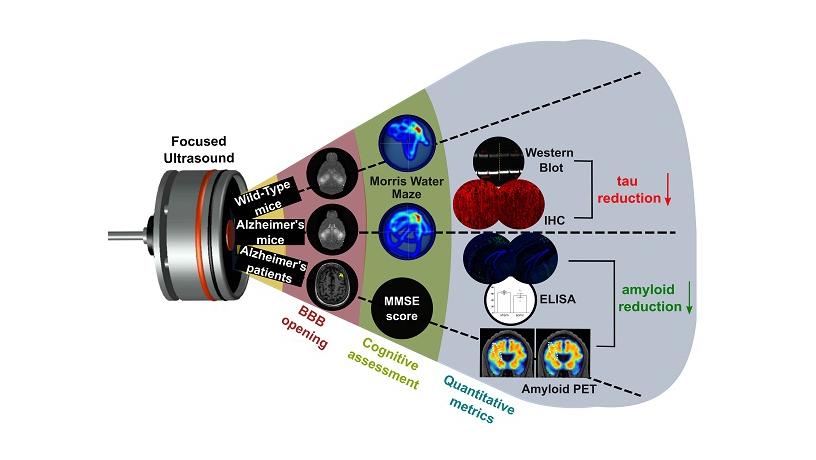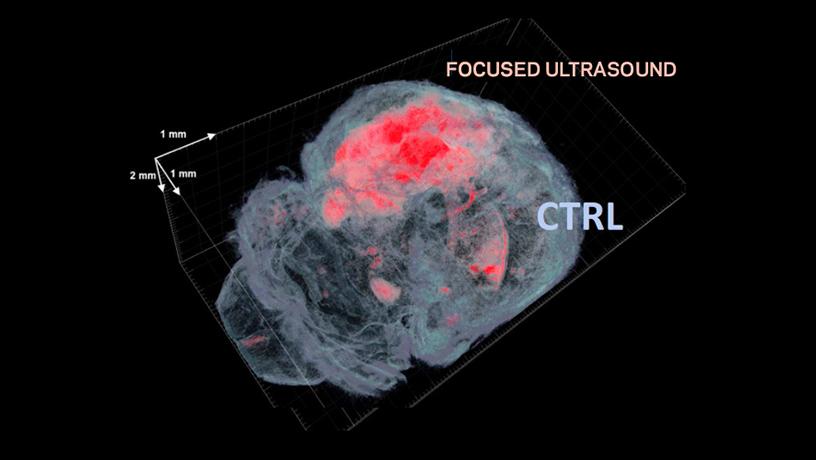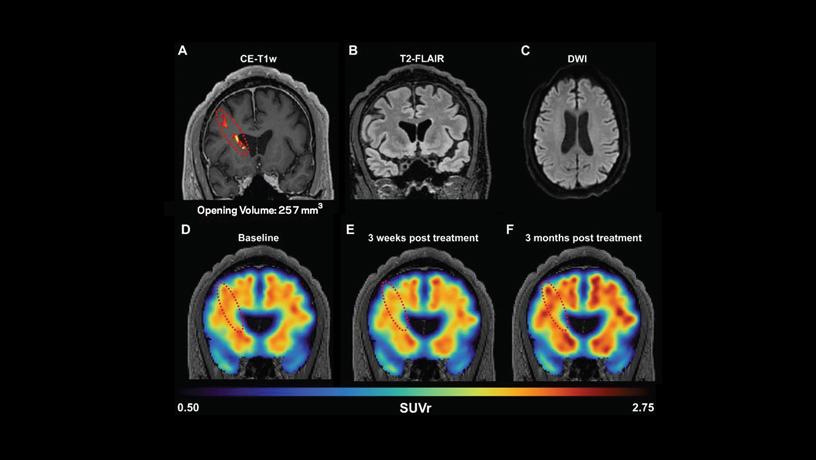Using Focused Ultrasound to Treat Alzheimer’s and Parkinson’s
Biomedical engineer Elisa Konofagou uses focused ultrasound to non-invasively open the blood-brain-barrier to deliver drugs and apply gene therapy

Focused ultrasound can awaken the brain immune system in mice. Credit: Ultrasound and Elasticity Imaging Laboratory/Columbia Engineering. (Published July 4 in Theranostics)
Ultrasound and Elasticity Imaging Laboratory
The Ultrasound and Elasticity Imaging Laboratory, led by Robert and Margaret Hariri Professor of Biomedical Engineering Elisa Konofagou, develops novel, ultrasound-based techniques for both imaging and therapeutic applications. The group has designed algorithms that can detect minute deformation in tissues as a result of physiological function, such as in the heart and vessels, and displacements induced by the ultrasound wave itself, such as in tumors and nerves. They also use focused ultrasound to target drug delivery to the brain by non-invasively opening the blood-brain barrier (BBB) and to modulate neural activity in the central and peripheral nervous system. The BBB is a natural protective layer in our brain; the barrier also limits the ability of systemic medications to reach their targets in the brain, posing a challenge to the delivery of effective therapies for certain brain diseases. The team works closely with physicians at Columbia University Irving Medical Center at New York-Presbyterian Hospital to translate these technologies to the clinic.

Mouse brain 3D fluorescence imaging with CLARITY showcasing the BBB opened volume for gene delivery. Credit: Ultrasound and Elasticity Imaging Laboratory/Columbia Engineering. (Published Aug. 22 in PNAS)
Brain Work
Using gene therapy to treat many neurologic diseases, such as Alzheimer’s and Parkinson’s, has long been a long-sought goal of researchers, but the blood-brain barrier has proven very difficult to cross. Over the past four years, Konofagou has been working with Kam Leong, Samuel Y. Sheng Professor of Biomedical Engineering, to deliver gene-editing vectors, a carrier genetically engineered to deliver genetic material, to the brain by using focused ultrasound with microbubbles to open the blood-brain barrier.
Konofagou’s group has also been using the same technology to treat Alzheimer’s, the predominant neurodegenerative disease that is projected to sharply increase its incidence over the next 10 years with advances in early detection and an increase in the aging population and average age overall.
The Breakthrough
The team has recently published two papers that spotlight major advances in their technology.
Published Aug. 22 in PNAS, “Focused ultrasound–mediated brain genome editing” demonstrates that the use of focused ultrasound and systemically administered microbubbles to open the BBB not only enables genome editing but also increases the gene copies by 20 times. This technology enables delivery of gene-editing vectors that can edit the genome of neuronal cells and potentially correct genes that code for brain diseases such as Alzheimer’s through the expression of such genes as ApoE4 and ApoE2 and also for other rare, monogenic brain pathologies.
Published July 4 in Theranostics, “Focused ultrasound mitigates pathology and improves spatial memory in Alzheimer's mice and patients” demonstrates that the BBB opening alone awakens the brain immune system in mice. This trigger then lowers the beta amyloid and tau loads--the two hallmark Alzheimer’s proteins--while also improving working memory. The researchers were able to apply this focused ultrasound technique to Alzheimer’s patients in a clinical trial and found that there was also a modest beta amyloid reduction in the region of the BBB opening relative to the untreated contralateral brain region.
Promising Treatment of Alzheimer’s
Taken together, these two papers show that focused ultrasound can facilitate the treatment of Alzheimer’s either by enhancing gene-editing delivery and expression or by focused ultrasound immunomodulation. This new technique can induce both methods--gene editing and immunomodulation--at the same time and, Konofagou notes, “The resulting synergistic effect could prove pivotal in the treatment of Alzheimer’s, especially at its early stages. We’re very excited about this.”

MRI and PET scans of an Alzheimer’s patient receiving FUS in a small region of the brain (A) with MRI scans determining safety (B,C). The PET scan ishows small reduction of SUVR (indicating beta amyloid load) between before FUS (D) and 3 weeks after a single FUS (E) with long-term increase beyond that (F). Credit: Ultrasound and Elasticity Imaging Laboratory/Columbia Engineering. (Published July 4 in Theranostics)
What’s Next
The Konofagou group is now testing their focused ultrasound technique on Alzheimer’s patients to reduce both tau and beta amyloid loads as well as to ameliorate memory deficits. They are also working with the Leong group to translate their gene-editing technique to the clinic.
